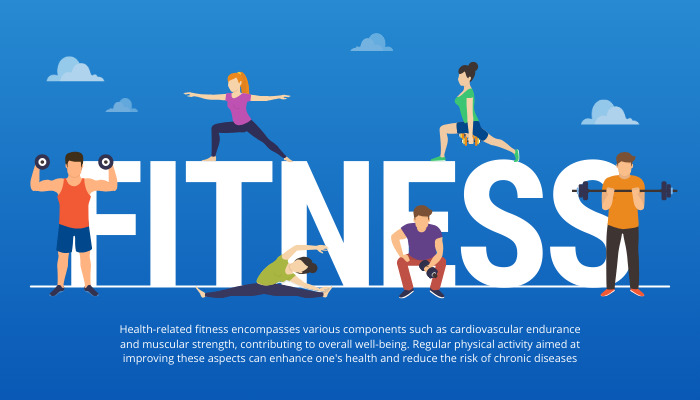
The 7 Key Components of Health-Related Fitness

7 Key Components of Health-Related Fitness
Health and fitness play an increasingly vital role in our 21st century lives. Maintaining strong personal health and fitness can help prevent chronic disease, improve quality of life, and even extend one’s lifespan. An important aspect of overall health is fitness – which refers to the body’s ability to function efficiently and effectively fulfill its physiological roles. There are seven major components that comprise full health-related fitness: cardiovascular endurance, muscular strength, muscular endurance, flexibility, body composition, balance, and agility. Mastering these seven key components can lead to improved health outcomes, enhanced physical performance, and an overall better quality of life.
Cardiovascular Endurance
Cardiovascular endurance refers to the ability of the heart, lungs, and circulatory system to efficiently supply oxygen and nutrients to working muscles during sustained physical activity. It is vital for correctly performing exercises like walking, running, swimming, and dancing. Some key facts:
- Reduces the risk of heart disease, high blood pressure, strokes, and premature death
- Improves the functional capacity of the lungs to process oxygen
- Enables the heart to pump blood with less effort
- Allows blood vessels to expand and contract easily
- Helps prevent dangerous plaque build-up in arteries
To improve cardiovascular endurance, experts recommend 30-60 minutes per day of continuous moderate-intensity cardio exercise. This elevated heart rate activity causes your body to adapt by making the heart muscle stronger and improving blood circulation efficiency. Excellent endurance-boosting exercises include:
- Running or jogging
- Swimming
- Cycling
- Rowing
- Jumping rope
- Aerobics classes
- Sports like soccer, basketball, tennis
These sustained cardio workouts trigger your heart rate to rise while conditioning your body to take in, transport, and utilize oxygen. Over time, this strengthens your cardiovascular system and boosts endurance.
Muscular Strength
Muscular strength enables muscles to exert maximal force against resistance. It is vital for posture, bone health, injury prevention, and effective performance of everyday physical tasks. Key facts on muscular strength:
- Provides the power necessary for lifting, pushing and carrying heavy objects
- Assists in injury prevention by protecting joints from trauma and overuse
- Reduces the risk of conditions like back pain, arthritis and osteoporosis later in life
- Supports balance, stability and bodily coordination
- Improves bone mineral density since bone adapts and strengthens in response to muscular contractions
To build muscular strength, participate in resistance training with free weights, resistance bands, weight machines or via bodyweight exercises like push-ups and squats. This stresses your muscular system so your body adapts by getting stronger. Follow these tips:
- Train each major muscle group 2-3 times per week
- Lift challenging weights that fatigue muscles after 8-12 reps
- Progressively increase weight amounts as you grow stronger
- Target all major muscle groups including legs, hips, back, chest, shoulders, arms, and core
- Allow for 1-2 rest days between resistance training sessions
Adding regular resistance training is crucial for developing sufficient muscular strength for health and daily activity.
Muscular Endurance
Muscular endurance entails the muscle’s ability to repeat contractions over an extended period without fatigue. It enables sustained physical activity vital for sports like soccer, hockey, tennis, basketball, hiking and more. Here are key muscular endurance facts:
- Necessary for sports requiring prolonged exertion
- Allows muscles to continue contracting over long periods without tiring
- Increases resistance to cramps and muscle strain
- Bolsters joints, tendons and ligaments against trauma
- Improves posture and back health
To build endurance, use low/moderate weight resistance training with higher rep counts, which fatigues muscles without overexertion. Also try:
- Bodyweight exercises like pushups, crunches, lunges and squats
- Dynamic lifting circuits with little rest between exercises
- Active sports that keep muscles working like basketball, soccer and dancing
Training for muscular endurance allows you to reap major functional fitness benefits.
Flexibility
Flexibility refers to the range of motion available in your joints and muscles. It is vital for injury prevention, optimizing athletic performance, and executing daily activities. Key flexibility facts:
- Allows fluid, comfortable movement of joints through complete range of motion
- Prevents muscle tightness and strain during routine motions
- Reduces stiffness in joints to enable activities requiring ample reach
- Lowers risk of complications like chronic back pain and posture issues
To improve flexibility:
- Perform dynamic stretches and static stretches 2-3 days per week
- Focus on major muscle groups like hips, back, hamstrings, chest and shoulders
- Stretch gently until mild tension – no bounce or pain should occur
- Hold static stretches for 30-60 seconds to allow muscles to relax and extend
- Stretch while muscles are warm after physical activity
Dedicate time to maintain and expand your range of motion for lifelong comfort and mobility.
Body Composition
Body composition refers to the relative ratio of fat mass to lean mass in your body. It has major implications for health, fitness and physical abilities. Key facts on body composition:
- Influences muscle strength, metabolism, mobility and physical functioning
- Excess fat mass raises risks for heart disease, diabetes, stroke and some cancers
- Low body fat limits energy reserves and physiological buffering capacity
- Common measures include Body Mass Index (BMI), skin fold tests, and DEXA scans
- Ideals: men 8-19% body fat, women 21-33% body fat
Improving body composition involves:
- Aerobic and resistance training to build lean muscle
- Balanced diet with appropriate calories and nutrients
- Adequate intake of protein to maintain and build muscle
- Healthy fats that assist vitamin absorption and hormone production
- Hydration to aid metabolism and circulatory functions
Consult fitness professionals to help devise an integrated diet and exercise plan tailored to your body composition goals.
Balance
Balance refers to the ability to maintain equilibrium while stationary or moving, and quickly regain stability after motion. It is vital for optimal performance in sports, safely executing everyday tasks, and reducing risk of falls and injury. Key facts on balance:
- Involves coordination of visual and vestibular sensory input
- Decreases naturally with aging as sensory systems deteriorate
- Essential for maximizing athletic excellence in sports like figure skating and gymnastics
- Required to safely complete routine motions like bending over or walking on uneven terrain
To boost balance, perform exercises like:
- One-leg stands
- Walking toe to heel in a straight line
- Tai Chi movements and forms
- Pilates reformer routines
- Yoga poses like tree pose and eagle pose
Practicing such dynamic and static balance drills can pay huge dividends in retaining stability and coordination with age.
Agility
Agility refers to the ability to rapidly and precisely move the body in different directions without losing balance or control. It enables efficient change of direction and position. Key agility facts:
- Critical for success in sports like tennis, basketball, football, boxing and hockey
- Involves coordinated integration of balance, speed, reflexes and strength
- Enables safe, controlled movements during intense sports performance
- Reduces risk of joint pain or soft tissue injury during explosive maneuvers
- Declines earlier than strength and endurance in the aging process
Boost agility through:
- Plyometric exercises that involve rapid explosive movement like bounding jumps
- Agility ladder and cone drills requiring multi-directional running
- Reaction ball exercises needing quick adaptation
- Sport-specific explosive movement training
Emphasizing agility enhances fitness while allowing peak sports performance with reduced injury risk.

Conclusion
In summary, attaining mastery across all seven components of health-related fitness enables you to achieve elevated physical functioning, improved health outcomes, powerful athletic performance and an enhanced quality of life across your lifespan. Structuring comprehensive fitness regimens tailored to individual needs and abilities can help in fully optimizing each fitness component. Dedicate time and discipline towards overall functional fitness excellence to reap the substantial and lifelong rewards.




